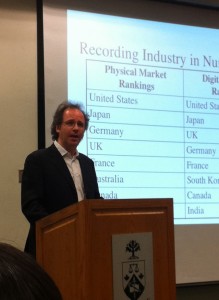By Susan Deefholts (2L)
For complete coverage of Michael Geist's talk, and other conference events, visit the Innovation Law Blog.

“Initially, my plan was to talk about the emergence of a user perspective,” Michael Geist, well-known tech guru and University of Ottawa law professor, began, as a preface to his lively and packed talk recently at the University of Toronto Faculty of Law. Geist was here as part of the 2011 Technology and Intellectual Property Group Conference. “But, as I followed the events over the past week on the blog, I decided to provide an alternative perspective to what has been discussed.”
Geist spoke about some of the issues that had been covered in the previous presentations at the conference, taking aim at some of the common Canadian copyright misconceptions.
Geist suggested the perception that we have weak protection laws in Canada, thus making it a haven for infringement, likely originates in the US. The USTR 301 report, which had been cited on previous days in support of the strengthening of copyright laws, includes much of the world on its list. He pointed out that even the Canadian government is aware of the issue of the problematic US standard, quoting an observation that the 301 watch list is US industry-driven, rather than derived from objective and reliable analysis.
Geist pointed out that if you look at the World Economics Forum Global Competitiveness Report, by contrast, Canada comes out well. He then displayed a list of the types of laws that we do have in Canada, some of which, he pointed out, provide very strong protections—“Stronger not necessarily meaning better,” he added, before describing some of the problems he has with one of the more stringent access laws, as it currently stands.
Geist then moved on to a more detailed analysis of C-32, starting with a discussion of the Notice & Notice system as it currently stands. “It works quite well, right now,” he concluded, pointing out that statistically, 71% of the time the current system is actually effective.
Some of the other claims include the allegation that changes to the statutory damages laws will amount to a license to steal, under C-32’s changed statutory damages for infringement. Yet, the non-commercial infringements penalties listed range from $100 to $5000, “which hardly seems to me to be a license to steal,” Geist remarked. “What it comes down to is that statutory damages for this kind of infringement are incredibly rare… The reality is that most countries have rejected this approach entirely. Most say, let’s look at the actual harm and calculate damages based on that.”
Another common claim is that C-32’s user generated content provisions license users to do almost anything. “UGC is something we should be encouraging, and that is precisely what this bill proposes to do.” The provision in the bill stipulates that UGC has to meet four requirements, including attribution and non-commercial purposes. In addition, the source should be non-infringing, and there should be no substantial adverse effect—including financial—on exploitation of existing work. Geist pointed out that this provision is actually fairly limited and narrow in its scope.”
He also critiqued the claim that there will be $126 million in alleged lost fees, as a result of C-32. While conceding that some of these numbers are justified, he pointed out that the figures pertaining to the lack of an iPod levy as well as the loss as a result of the education exception under fair dealing, are highly speculative and based on assumptions that are possibly false.
Geist concluded by examining the claim that C-32 will make Canada compliant with the WIPO Internet Treaties.
“It is true that C-32 will make us compliant with WIPO—but the question is whether this is the only way to become compliant with WIPO.” The current, proposed anti-circumvention provisions are problematic, for instance. Under C-32 “we are basically getting three layers of protection”—copyright law is the first layer, the technology is the second layer and the legislation, which provides protection, “not for the work, but for the technology.” Though there are exceptions, even in the context of the limited number of exceptions currently in place, many are too narrow and are problematic. As an example, he discussed the perceptual disability exception, and some problems associated with it.
Geist wrapped up his discussion of the WIPO treaty by discussing the legislative history behind the treaty, pointing that even after “several years of discussion… you get no consensus.” There was no endorsement of the basic proposal, such that the ultimate language is very general. The end result of this lack of consensus is that countries have a good deal of freedom with regard to how they try to implement WIPO treaty terms.
Photo by Christy Zhou

